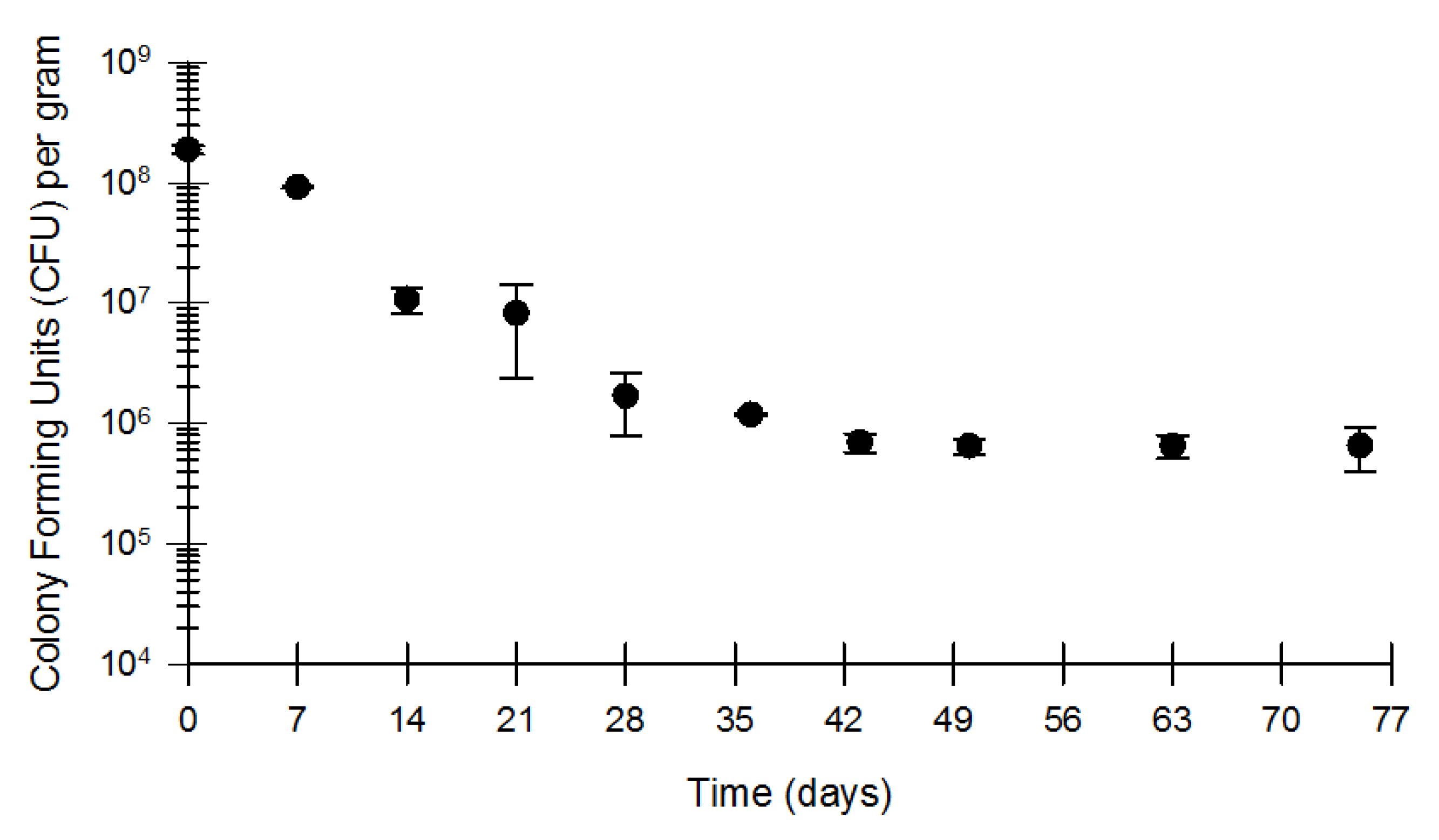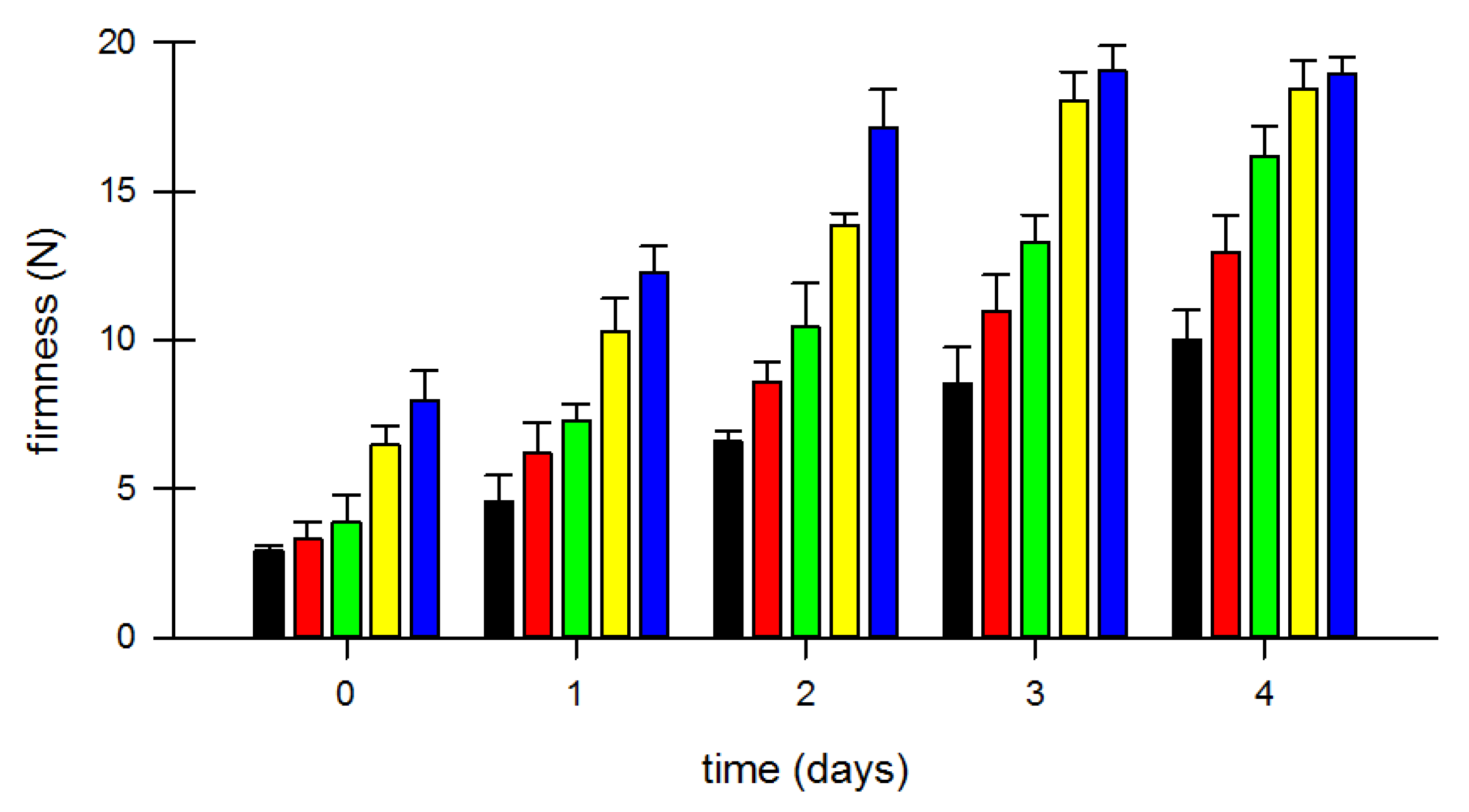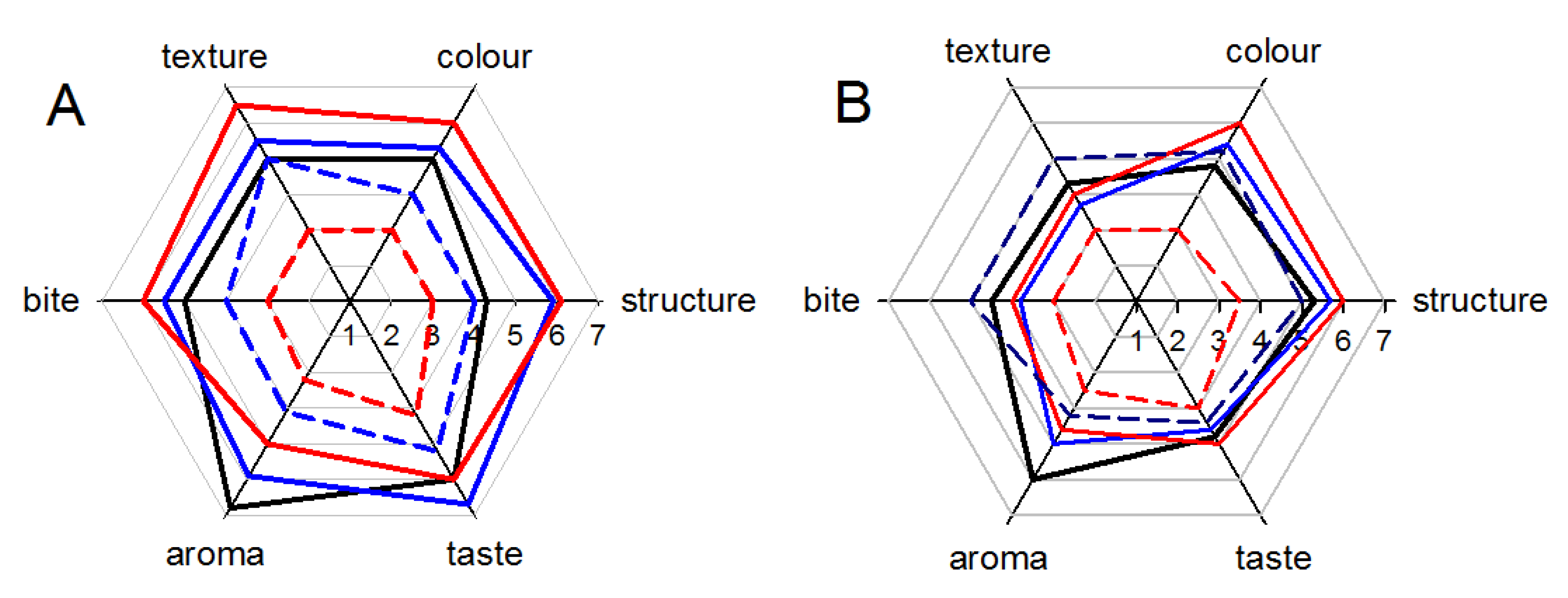Incorporation of Fermented Brewers Spent Grain in the Production of Sourdough Bread
Abstract
:1. Introduction
2. Material and Methods
2.1. Bread Related Materials
2.1.1. Solid State Fermentation and Processing of Brewers Spent Grain
2.1.2. Bread Making
2.1.3. Sourcing of Commercially Available Sourdough Breads
2.2. Analysis
2.2.1. Quality and Sensorial Analysis
2.2.2. Microbial Analysis
2.2.3. Organic Acid Analysis
2.2.4. Statistical Analysis
3. Results and Discussion
3.1. Bacterial Solid-State Fermentation of Brewers Spent Grain
3.2. Sourdough Production with Fermented Brewers Spent Grain
3.2.1. Rate of FBSG Incorporation for the Production of Sourdough
3.2.2. Sensory Perception of Sourdough Bread Made with FBSG
3.2.3. Acid Profile of Sourdough Made with FBSG
4. Conclusions
Author Contributions
Funding
Institutional Review Board Statement
Informed Consent Statement
Data Availability Statement
Acknowledgments
Conflicts of Interest
References
- Stojceska, V. Brewer’s spent grain from by-product to health: A rich source of functional ingredients. In Flour and Breads and Their Fortification in Health and Disease Prevention, 2nd ed.; Preedy, V.R., Watson, R.R., Eds.; Academic Press: Cambridge, MA, USA, 2019; pp. 189–198. [Google Scholar]
- Gastl, M.; Kupetz, M.; Becker, T. Determination of Cytolytic Malt Modification–Part II: Impact on Wort Separation. J. Am. Soc. Brew. Chem. 2021, 79, 66–74. [Google Scholar]
- Charlton, P.; Vriesekoop, F. Brewery by-Products. In Handbook of Brewing, 3rd ed.; Stewart, G.G., Russell, I., Anstruther, A., Eds.; CRC Press: London, UK, 2017; pp. 567–589. [Google Scholar]
- Mussatto, S.I.; Dragone, G.; Roberto, I.C. Brewers’ spent grain: Generation, characteristics and potential applications. J. Cereal Sci. 2006, 43, 1–14. [Google Scholar] [CrossRef]
- Steinmacher, N.C.; Honna, F.A.; Gasparetto, A.V.; Anibal, D.; Grossmann, M.V. Bioconversion of brewer’s spent grains by reactive extrusion and their application in bread-making. LWT 2012, 46, 542–547. [Google Scholar] [CrossRef]
- Buffington, J. The economic potential of brewer’s spent grain (BSG) as a biomass feedstock. Adv. Chem. Eng. Sci. 2014, 4, 308–318. [Google Scholar] [CrossRef] [Green Version]
- Bochmann, G.; Drosg, B.; Fuchs, W. Anaerobic digestion of thermal pretreated brewers’ spent grains. Environ. Prog. Sustain. Energy 2015, 34, 1092–1096. [Google Scholar] [CrossRef]
- Nassary, E.K.; Nasolwa, E.R. Unravelling disposal benefits derived from underutilized brewing spent products in Tanzania. J. Environ. Manag. 2019, 242, 430–439. [Google Scholar] [CrossRef]
- Kerby, C.; Vriesekoop, F. An overview of the utilisation of brewery by-products as generated by british craft breweries. Beverages 2017, 3, 24. [Google Scholar] [CrossRef] [Green Version]
- Nayak, A.; Bhushan, B. An overview of the recent trends on the waste valorization techniques for food wastes. J. Environ. Manag. 2019, 233, 352–370. [Google Scholar] [CrossRef]
- Mussatto, S.I. Brewer’s spent grain: A valuable feedstock for industrial applications. J. Sci. Food Agric. 2014, 94, 1264–1275. [Google Scholar] [CrossRef] [Green Version]
- Garcia-Garcia, G.; Woolley, E.; Rahimifard, S. Optimising industrial food waste management. Procedia Manuf. 2017, 8, 432–439. [Google Scholar] [CrossRef] [Green Version]
- Waters, D.M.; Jacob, F.; Titze, J.; Arendt, E.K.; Zannini, E. Fibre, protein and mineral fortification of wheat bread through milled and fermented brewer’s spent grain enrichment. Eur. Food Res. Technol. 2012, 235, 767–778. [Google Scholar] [CrossRef]
- Katina, K.; Heiniö, R.L.; Autio, K.; Poutanen, K. Optimization of sourdough process for improved sensory profile and texture of wheat bread. LWT 2006, 39, 1189–1202. [Google Scholar] [CrossRef]
- Katina, K.; Liukkonen, K.H.; Kaukovirta-Norja, A.; Adlercreutz, H.; Heinonen, S.M.; Lampi, A.M.; Pihlava, J.M.; Poutanen, K. Fermentation-induced changes in the nutritional value of native or germinated rye. J. Cereal Sci. 2007, 46, 348–355. [Google Scholar] [CrossRef]
- Poutanen, K.; Flander, L.; Katina, K. Sourdough and cereal fermentation in a nutritional perspective. Food Microbiol. 2009, 26, 693–699. [Google Scholar] [CrossRef] [PubMed]
- Denkova, R.; Ilieva, S.; Denkova, Z.; Georgieva, L.; Yordanova, M.; Nikolova, D.; Evstatieva, Y. Production of wheat bread without preservatives using sourdough starters. Biotechnol. Biotechnol. Equip. 2014, 28, 889–898. [Google Scholar] [CrossRef]
- Aprodu, I.; Simion, A.B.; Banu, I. Valorisation of the Brewers’ Spent Grain through Sourdough Bread Making. Int. J. Food Eng. 2017, 13, 20170195. [Google Scholar] [CrossRef]
- Ktenioudaki, A.; O’Shea, N.; Gallagher, E. Rheological properties of wheat dough supplemented with functional by-products of food processing: Brewer’s spent grain and apple pomace. J. Food Eng. 2013, 116, 362–368. [Google Scholar] [CrossRef]
- Ktenioudaki, A.; Chaurin, V.; Reis, S.F.; Gallagher, E. Brewer’s spent grain as a functional ingredient for breadsticks. Int. J. Food Sci. Technol. 2012, 47, 1765–1771. [Google Scholar] [CrossRef] [Green Version]
- Mintel. Bread–UK–September 2018–Executive Summary. Mintel. 2018. Available online: http://0-academic-mintel-com.brum.beds.ac.uk/display/917730/?highlight#hit1 (accessed on 5 May 2021).
- Plessas, S. Innovations in Sourdough Bread Making. Fermentation 2021, 7, 29. [Google Scholar] [CrossRef]
- Sakandar, H.A.; Hussain, R.; Kubow, S.; Sadiq, F.A.; Huan, W.; Imran, M. Sourdough bread: A contemporary cereal fermented product. J. Food Process. Preserv. 2019, 43, e13883. [Google Scholar] [CrossRef]
- Sieuwerts, S.; Bron, P.A.; Smid, E.J. Mutually stimulating interactions between lactic acid bacteria and Saccharomyces cerevisiae in sourdough fermentation. LWT 2018, 90, 201–206. [Google Scholar] [CrossRef]
- Do Nascimento, K.D.O.; Paes, S.D.N.D.; Augusta, I.M. A review “Clean Labeling”: Applications of natural ingredients in bakery products. J. Food Nutr. Res. 2018, 6, 285–294. [Google Scholar] [CrossRef]
- Chavan, R.S.; Chavan, S.R. Sourdough technology—a traditional way for wholesome foods: A review. Compr. Rev. Food Sci. Food Saf. 2011, 10, 169–182. [Google Scholar] [CrossRef]
- Upadhyay, R.; Ghosal, D.; Mehra, A. Characterization of bread dough: Rheological properties and microstructure. J. Food Eng. 2012, 109, 104–113. [Google Scholar] [CrossRef]
- Rasco, B.A.; Hashisaka, A.E.; Dong, F.M.; Einstein, M.A. Sensory evaluation of baked foods incorporating different levels of distillers’ dried grains with solubles from soft white winter wheat. J. Food Sci. 1989, 54, 337–342. [Google Scholar] [CrossRef]
- Lawless, H.T. Laboratory Exercise for Sensory Evaluation; Springer: New York, NY, USA, 2013. [Google Scholar]
- Meilgaard, M.C.; Civille, G.V.; Carr, B.T. Sensory Evaluation Techniques, 5th ed.; CRC Press, Taylor Francis Group: Boca Raton, FL, USA, 2016. [Google Scholar]
- Lawless, H.T.; Heymann, H. Sensory Evaluation of Food, 2nd ed.; Springer: New York, NY, USA, 2010. [Google Scholar]
- Roth, M.; Döring, C.; Jekle, M.; Becker, T. Mechanisms behind distiller’s grains impact on wheat dough and bread quality. Food Bioprocess Technol. 2016, 9, 274–284. [Google Scholar] [CrossRef]
- Sullivan, P.; O’Flaherty, J.; Brunton, N.; Arendt, E.; Gallagher, E. The utilisation of barley middlings to add value and health benefits to white breads. J. Food Eng. 2011, 105, 493–502. [Google Scholar] [CrossRef]
- Seyer, M.È.; Gélinas, P. Bran characteristics and wheat performance in whole wheat bread. Int. J. Food Sci. Technol. 2009, 44, 688–693. [Google Scholar] [CrossRef]
- Wang, J.; Rosell, C.M.; de Barber, C.B. Effect of the addition of different fibres on wheat dough performance and bread quality. Food Chem. 2002, 79, 221–226. [Google Scholar] [CrossRef]
- Miafo, A.P.T.; Koubala, B.B.; Kansci, G.; Muralikrishna, G. Free sugars and non-starch polysaccharides–phenolic acid complexes from bran, spent grain and sorghum seeds. J. Cereal Sci. 2019, 87, 124–131. [Google Scholar] [CrossRef]
- Brochetti, D.; Penfield, M.P.; Heim-Edelman, F. Yeast bread containing distillers’ dried grain: Dough development and bread quality. J. Food Qual. 1991, 14, 331–344. [Google Scholar] [CrossRef]
- Fadda, C.; Sanguinetti, A.M.; Del Caro, A.; Collar, C.; Piga, A. Bread staling: Updating the view. Compr. Rev. Food Sci. Food Saf. 2014, 13, 473–492. [Google Scholar] [CrossRef] [Green Version]
- Brancoli, P.; Lundin, M.; Bolton, K.; Eriksson, M. Bread loss rates at the supplier-retailer interface–analysis of risk factors to support waste prevention measures. Resour. Conserv. Recycl. 2019, 147, 128–136. [Google Scholar] [CrossRef]
- Gmose, R.; Fristedt, R.; Larsson, K.; Undeland, I.; Taherzadeh, M.J.; Lennartsson, P.R. From stale bread and brewers spent grain to a new food source using edible filamentous fungi. Bioengineered 2020, 11, 582–598. [Google Scholar] [CrossRef]
- Curti, E.; Carini, E.; Tribuzio, G.; Vittadini, E. Effect of bran on bread staling: Physico-chemical characterization and molecular mobility. J. Cereal Sci. 2015, 65, 25–30. [Google Scholar] [CrossRef]
- Ahlborn, G.J.; Pike, O.A.; Hendrix, S.B.; Hess, W.M.; Huber, C.S. Sensory, mechanical, and microscopic evaluation of staling in low-protein and gluten-free breads. Cereal Chem. 2005, 82, 328–335. [Google Scholar] [CrossRef]
- Marinopoulou, A.; Papadakis, D.; Petridis, D.; Papageorgiou, M. Monitoring Staling of Packaged Sliced Pan Breads: Physicochemical Properties, Sensory Evaluation, and Consumer Preference. J. Culin. Sci. Technol. 2019, 18, 396–412. [Google Scholar] [CrossRef]
- Fujimoto, A.; Ito, K.; Narushima, N.; Miyamoto, T. Identification of lactic acid bacteria and yeasts, and characterization of food components of sourdoughs used in Japanese bakeries. J. Biosci. Bioeng. 2019, 27, 575–581. [Google Scholar] [CrossRef]
- Buksa, K. Effect of pentoses, hexoses, and hydrolyzed arabinoxylan on the most abundant sugar, organic acid, and alcohol contents during rye sourdough bread production. Cereal Chem. 2020, 97, 642–652. [Google Scholar] [CrossRef]
- Gobbetti, M.; Simonetti, M.S.; Corsetti, A.; Santinelli, F.; Rossi, J.; Damiani, P. Volatile compound and organic acid productions by mixed wheat sour dough starters: Influence of fermentation parameters and dynamics during baking. Food Microbiol. 1995, 12, 497–507. [Google Scholar] [CrossRef]
- Gobbetti, M.; De Angelis, M.; Corsetti, A.; Di Cagno, R. Biochemistry and physiology of sourdough lactic acid bacteria. Trends Food Sci. Technol. 2005, 16, 57–69. [Google Scholar] [CrossRef]
- Sui, X.; Yap, P.Y.; Zhou, W. Anthocyanins during baking: Their degradation kinetics and impacts on color and antioxidant capacity of bread. Food Bioprocess Technol. 2015, 8, 983–994. [Google Scholar] [CrossRef]
- Jensen, S.; Oestdal, H.; Skibsted, L.H.; Larsen, E.; Thybo, A.K. Chemical changes in wheat pan bread during storage and how it affects the sensory perception of aroma, flavour, and taste. J. Cereal Sci. 2011, 53, 259–268. [Google Scholar] [CrossRef]






| Sample | Organic Acid | mmol/kg, avg ± SD | Fermentation Quotient (FQ) * |
|---|---|---|---|
| Brewers spent grain | Lactic acid | ND ** | NA *** |
| Acetic acid | ND | ||
| Fermented brewers spent grain (wet) | Lactic acid | 53.56 ± 2.44 | 2.36 |
| Acetic acid | 22.67 ± 1.49 | ||
| Fermented brewers spent grain (dry) | Lactic acid | 692.01 ± 99.22 | 2.50 |
| Acetic acid | 277.01 ± 103.33 |
| Sourdough Sample | Organic Acid | mmol/kg avg ± SD | QF * |
|---|---|---|---|
| Negative control (0% FBSG and no bacterial starter culture). | Lactic acid | ND ** | NA *** |
| Acetic acid | ND | ||
| Positive control (0% FBSG, but with the inclusion of the bacterial starter culture) | Lactic acid | 11.11 ± 0.22 | 3.17 |
| Acetic acid | 3.50 ± 0.17 | ||
| 5% added FBSG | Lactic acid | 43.44 ± 4.89 | 2.83 |
| Acetic acid | 15.33 ± 1.49 | ||
| 10% added FBSG | Lactic acid | 62.44 ± 4.44 | 2.19 |
| Acetic acid | 28.49 ± 3.83 | ||
| 15% added FBSG | Lactic acid | 77.67 ± 4.55 | 1.81 |
| Acetic acid | 43.01 ± 7.17 | ||
| 20% added FBSG | Lactic acid | 93.44 ± 1.22 | 1.66 |
| Acetic acid | 56.17 ± 2.17 |
| Source of Sourdough Breads | Organic Acid | mmol/kg * (avg ± SD) ** | Range (mmol/kg) |
|---|---|---|---|
| Full range of sourdough breads (n = 32) | Lactic acid | 45.05 ± 19.56 | 5.67 ↔ 74.22 |
| Acetic acid | 21.83 ± 10.50 | 4.67 ↔ 42.83 | |
| Supermarket sourdough breads (n = 13) | Lactic acid | 36.04 ± 17.89 | 5.67 ↔ 31.22 |
| Acetic acid | 23.33 ± 11.16 | 4.67 ↔ 42.83 | |
| Artisan sourdough breads (n = 19) | Lactic acid | 53.22 ± 16.11 | 22.78 ↔ 74.22 |
| Acetic acid | 22.81 ± 7.51 | 10.83 ↔ 37.17 |
Publisher’s Note: MDPI stays neutral with regard to jurisdictional claims in published maps and institutional affiliations. |
© 2021 by the authors. Licensee MDPI, Basel, Switzerland. This article is an open access article distributed under the terms and conditions of the Creative Commons Attribution (CC BY) license (https://creativecommons.org/licenses/by/4.0/).
Share and Cite
Vriesekoop, F.; Haynes, A.; van der Heijden, N.; Liang, H.; Paximada, P.; Zuidberg, A. Incorporation of Fermented Brewers Spent Grain in the Production of Sourdough Bread. Fermentation 2021, 7, 96. https://0-doi-org.brum.beds.ac.uk/10.3390/fermentation7020096
Vriesekoop F, Haynes A, van der Heijden N, Liang H, Paximada P, Zuidberg A. Incorporation of Fermented Brewers Spent Grain in the Production of Sourdough Bread. Fermentation. 2021; 7(2):96. https://0-doi-org.brum.beds.ac.uk/10.3390/fermentation7020096
Chicago/Turabian StyleVriesekoop, Frank, Annie Haynes, Niels van der Heijden, Hao Liang, Paraskevi Paximada, and Antien Zuidberg. 2021. "Incorporation of Fermented Brewers Spent Grain in the Production of Sourdough Bread" Fermentation 7, no. 2: 96. https://0-doi-org.brum.beds.ac.uk/10.3390/fermentation7020096






